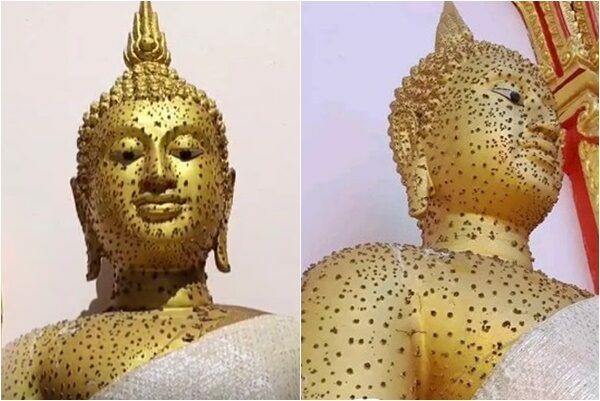Mysterious bumps on Buddha statue spark curiosity and lottery hopes in central Thailand

A peculiar phenomenon recently sparked curiosity among Thai citizens, as a Buddha statue at a renowned temple in Nakhon Nayok province developed mysterious bumps all over its body. The statue, dedicated to those born on a Friday, stands approximately 1.5 metres tall and has become a centre of attraction for lottery enthusiasts.
The event occurred today when pictures of the enigmatic Buddha statue began circulating online. The statue, located at Wat Bot Karong in Nakhon Nayok city centre, appeared to have its surface covered in bump-like formations. These hard formations, which could be felt upon touching the statue, created an unusual spectacle that attracted the attention of locals.
As the final lottery draw approached, locals began flocking to the temple, offering flowers and lighting candles in hopes of receiving lucky lottery numbers. The numbers 490 and 495 were seen as particularly auspicious.
Dr Pipat Krajaechan, an academic from the History Department of Thammasat University’s Faculty of Arts, provided insights into the strange phenomenon. He speculated that the bumps could be a result of humidity, although he was unsure of the material the statue was made from, reported KhaoSod.
If it is a newly crafted statue made from metal and coated with gold paint, the bumpy surface could be the result of rust caused by moisture, Dr Pipat explained.
“If the statue is made of metal, rust could form in spots like this when moisture seeps in from the concrete base on which the statue is placed. The surface then bulges out in small, bump-like formations.”
Buddha maintenance
However, if the statue is made from stone or moulded concrete, the moisture would seep through the pores and usually cause the surface to crack, not form bumps like metal.
“Newer statues are usually made from brass, a mixture of zinc and copper. In areas where copper accumulates, rust forms easily. Over time, I expect this Buddha statue to continue rusting and eventually the gold paint will have to be removed and the rust scrubbed off.”
In ancient times, a technique called Yang Rak was used, which involved applying a natural material on the surface before layering gold on top. This allowed for moisture to escape, unlike modern oil paints which tend to trap moisture, causing damage as seen in several news reports, such as the damaged Buddha statue at Wat Arun Ratchawararam, revealed Dr Pipat.
“Using oil paint is like covering the statue with a layer of paint, trapping the moisture inside. When the stone becomes damp, it cracks. But the ancient technique of applying Yang Rak and layering gold on top allows the moisture to escape.”
While the use of modern oil paint on ancient statues and archaeological sites might be seen as a misstep in terms of conservation, it’s also understandable that it’s part of an effort to maintain religious sites. Therefore, it’s suggested that the traditional technique be used in parallel.
However, this approach is costly and requires thousands to hundreds of thousands of baht. Communities might be able to help if they’re strong enough, concluded Dr Pipat.
Latest Thailand News
Follow The Thaiger on Google News:


























